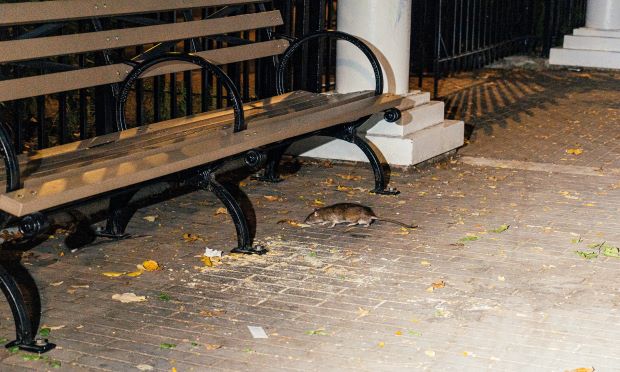NYC rats: They’re in the park, on your block and even at your table
By Ed Shanahan
NEW YORK — Brittany Brown and her friends were finishing an outdoor dinner in Chelsea recently when, from the corner of her eye, she thought she saw something move near the edge of their table.
Moments later, she thought she saw it again.
Then she made eye contact with a man sitting nearby, and he confirmed what worried her: A rat had been on the table. If that weren’t icky enough, one skittered through the restaurant shed as she left.
“It’s gross, and it’s kind of unnerving,” said Brown, a copy editor who has lived in Manhattan for four years. She did not want to name the restaurant and single it out for what she considers a bigger issue.
“This is the worst I’ve ever seen it,” she said.
Rodents are among New York’s permanent features. But across the city, one hears the same thing: They are running amok like never before.
Through Wednesday (3), there had been more than 21,000 rat sightings reported to 311 this year, compared with 15,000 in the same period in 2019 (and about 12,000 in 2014). The rate of initial health inspections to uncover “active rats signs” nearly doubled in the latest fiscal year. There have also been 15 cases this year — the most since at least 2006 — of leptospirosis, which can cause serious liver and kidney damage and, in the city, typically spreads via rat urine, according to health officials. One case was fatal.
So add a plague of rats to everything else New York faces in trying to rebound from the COVID-19 pandemic. By some measures, the problem may have eased slightly before the coronavirus came. But the rodents have roared back since, thanks to a confluence of factors.
The spike is mostly in areas long known as infested, health officials insist.
According to experts, exterminators and city officials, the perfect-pandemic-storm scenario behind the surge goes like this:
When restaurants closed, rats had to scavenge outside more. They found gutters and street-corner baskets clogged with trash because of cuts to the Sanitation Department budget last year. Illegal dumping increased. With most people stuck at home, so did residential waste.
A few months after the city shut down, construction, which drives rats into the open and had been halted like everything else, returned with gusto. Outdoor dining expanded as restaurants struggled to survive.
Along the way, inspectors who typically hunt for evidence of rats were assigned elsewhere, including to mass vaccination sites and to restaurants to ensure that they were requiring vaccination proof.
A wetter-than-usual summer, coupled with other impacts of a warming climate that have helped rats thrive, heightened the problem, health officials said. By October, the animals, which breed prolifically, had reached their annual population peak in the city, said Jason Munshi-South, an associate professor of biological sciences at Fordham University.
Now, as temperatures drop, rats may be somewhat less visible. But they will re-emerge en masse in spring, ready to feast.
When they do, critics say, the restaurant sheds that helped save an industry will be potential feeding grounds. Abandoned ones are already rodent playpens.
Edward Grayson, sanitation commissioner, acknowledged that the sheds, especially those that spill past the curb, complicate the department’s work and create more responsibilities for restaurants, which he expects they will meet.
“You’re not going to eat somewhere that’s disgusting,” Grayson said in an interview.
Last year’s budget cuts have largely been restored, he said, and the department “was doing everything we can to keep the streets clean.”
But Antonio Reynoso, a City Council member from Brooklyn who leads the sanitation committee and is the incoming borough president, said those efforts were lacking.
“The city feels dirtier,” Reynoso said, expressing a widely shared view.
Andy Linares, president of Bug Off Pest Control Center in upper Manhattan, said rats had undoubtedly “become more brazen in their quest for food and harborage.” He described watching one appear from under a dumpster and “saunter” across the street before slipping down a sewer grate.
“It was jaywalking,” said Linares, who has operated the business for 40 years.
New York’s most recent anti-rat initiative, a $32 million program in 2017, targeted what Mayor Bill de Blasio said were the three most-infested parts of the city: the Grand Concourse area of the Bronx; Bushwick and Bedford-Stuyvesant in Brooklyn; and a section of Manhattan encompassing the East Village, the Lower East Side and Chinatown.
Much of the money was earmarked for improving conditions in public housing, and some data suggests the program hit its goals for reducing rat activity in those areas by 2019. Now, with rodents ascendant again, the program’s future is unclear.
Stuffing dry ice into burrows is one way the city fights the war on rats. Linares, the exterminator, said poisons, bait boxes and other devices remained popular and that sales had increased during the pandemic. (The website The City reported last month that rat poison had killed at least six birds found dead in local parks since January 2020.)
As for the sheds, Andrew Rigie, executive director of the New York City Hospitality Alliance, a trade group, said most restaurant owners had been diligent in keeping the structures clean and were prepared for strict sanitary measures to be imposed should outdoor dining expand permanently.
“Maybe it will be the catalyst for New York to change how it deals with its garbage,” he said.
In the meantime, Brown cannot shake the memory of a rat joining her at the dinner table.
“It made me feel,” she said, “like maybe I’m over it with outdoor dining for now.”
-New York Times


